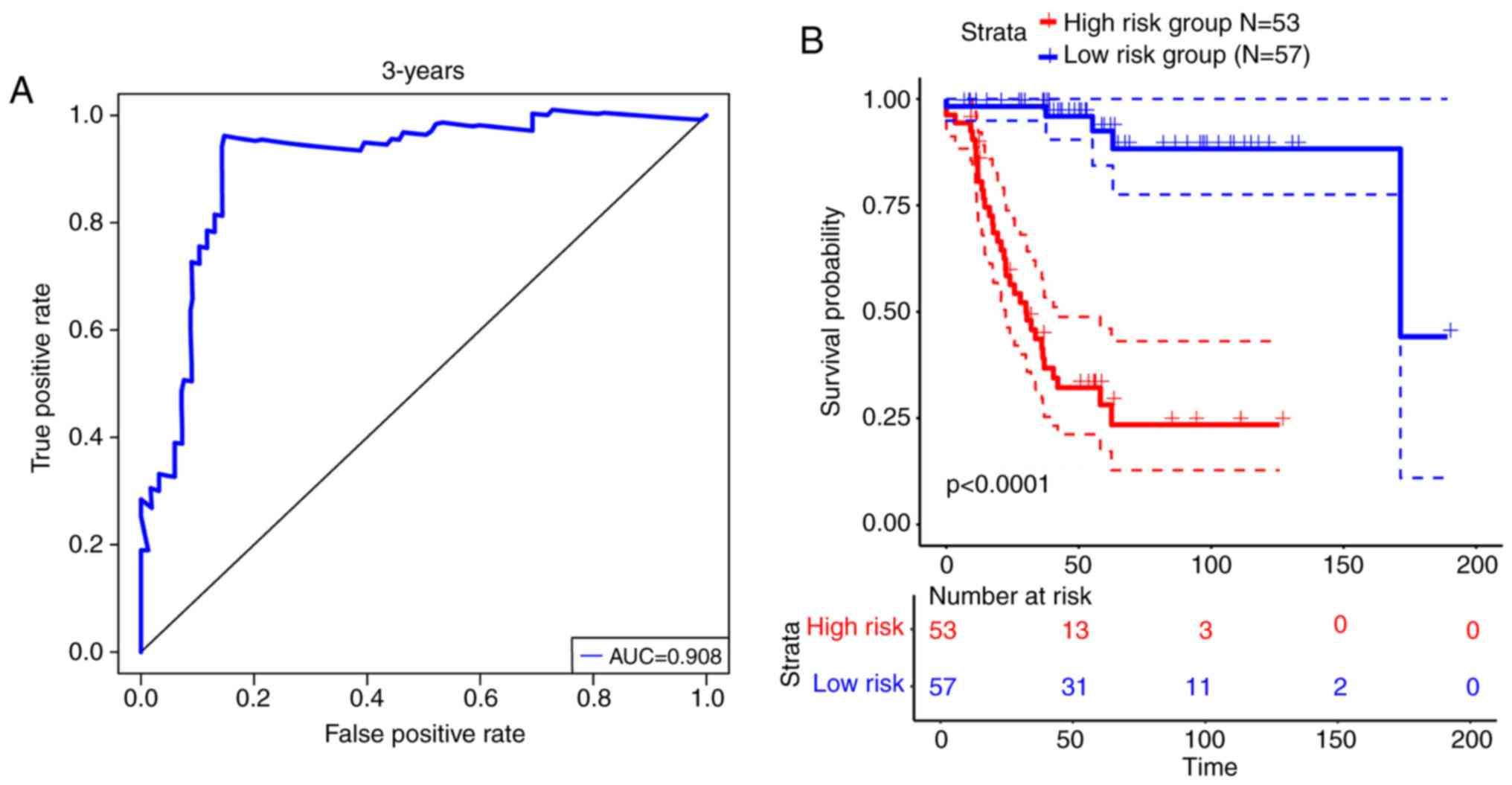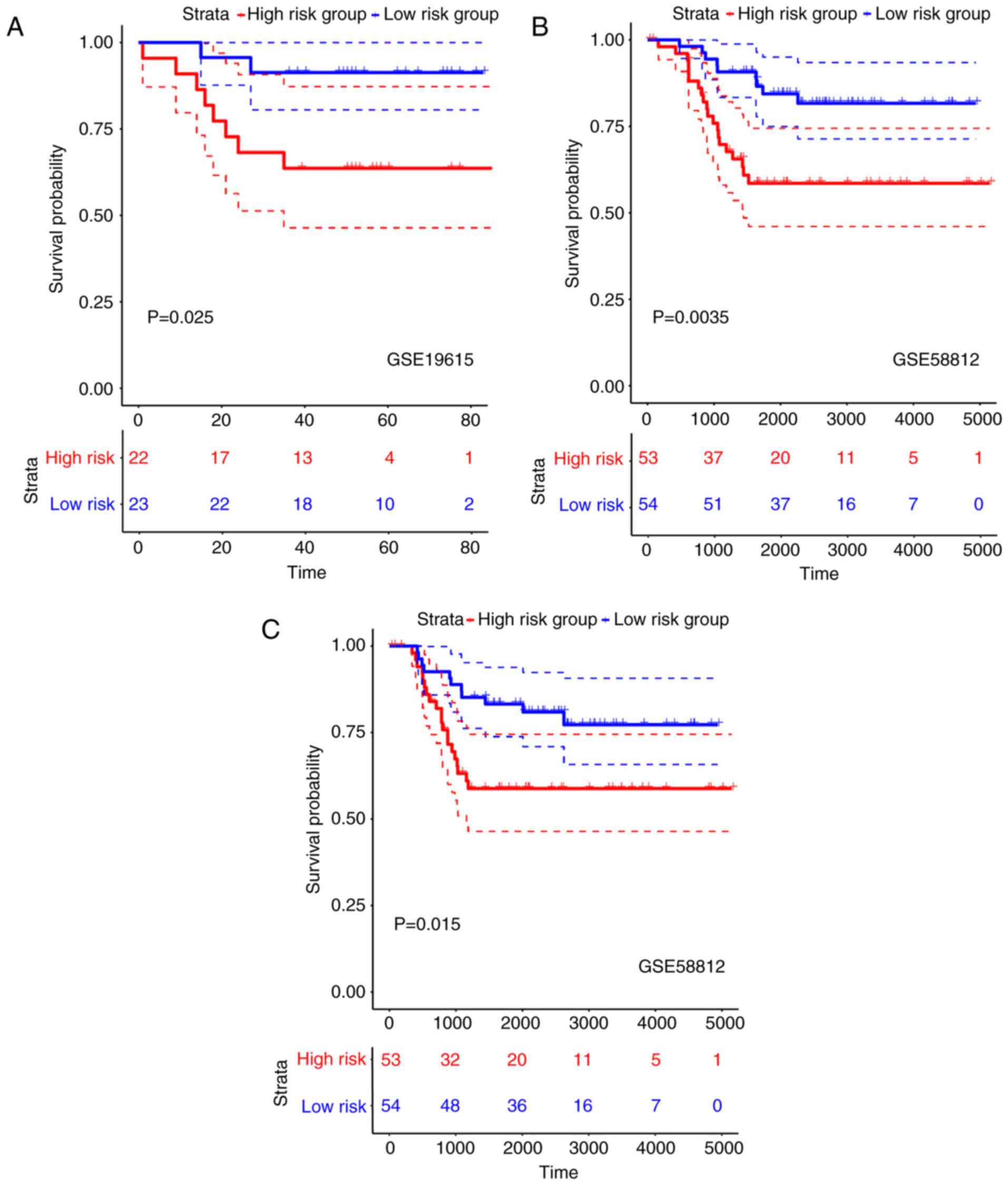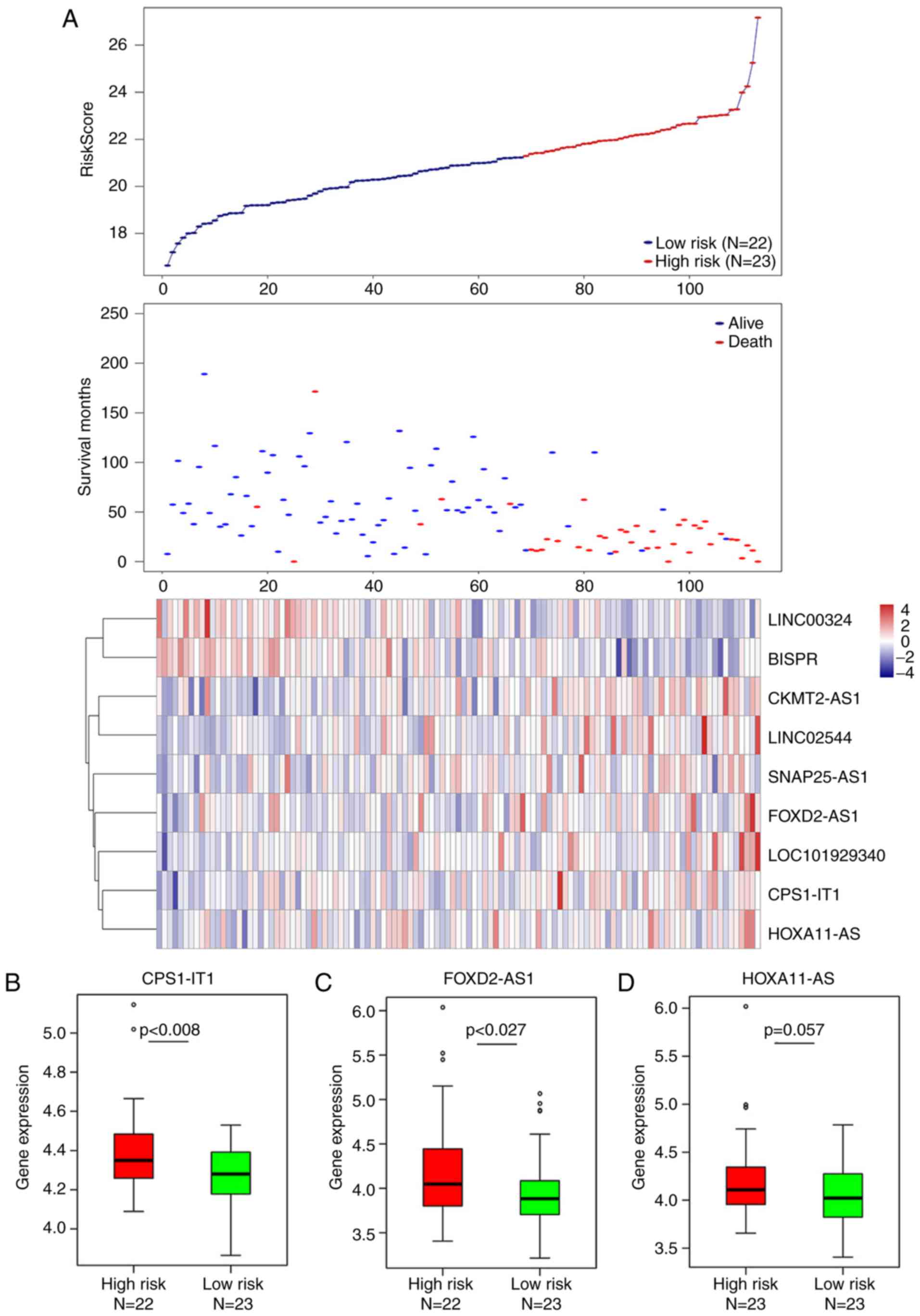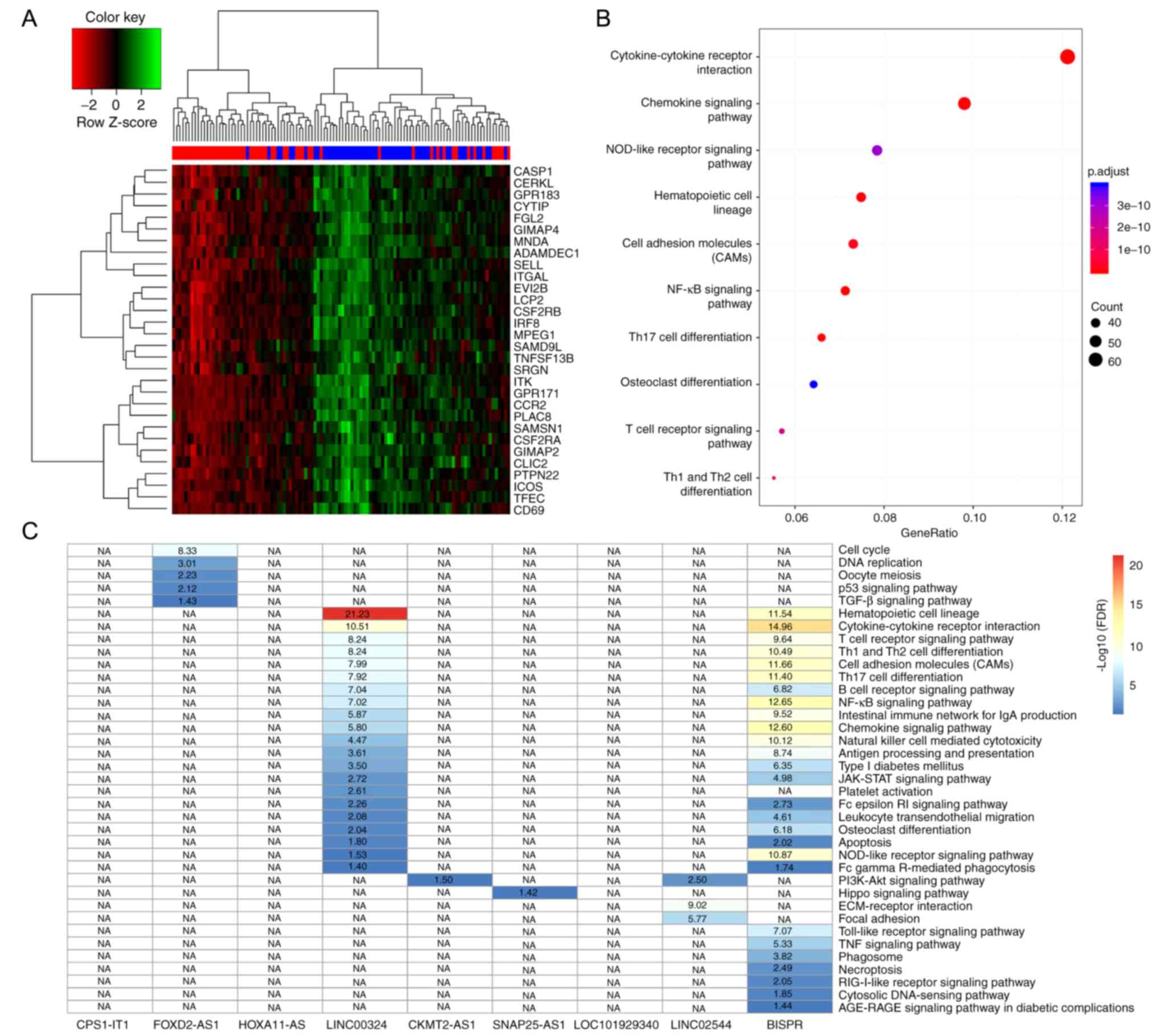|
1
|
DeSantis C, Ma J, Bryan L and Jemal A:
Breast cancer statistics, 2013. CA Cancer J Clin. 64:52–62. 2014.
View Article : Google Scholar : PubMed/NCBI
|
|
2
|
Siegel RL, Miller KD and Jemal A: Cancer
statistics, 2018. CA Cancer J Clin. 68:7–30. 2018. View Article : Google Scholar : PubMed/NCBI
|
|
3
|
Ma M, Huang W and Kong D: IL-17 inhibits
the accumulation of myeloid-derived suppressor cells in breast
cancer via activating STAT3. Int Immunopharmacol. 59:148–156. 2018.
View Article : Google Scholar : PubMed/NCBI
|
|
4
|
Shandley LM, Spencer JB, Fothergill A,
Mertens AC, Manatunga A, Paplomata E and Howards PP: Impact of
tamoxifen therapy on fertility in breast cancer survivors. Fertil
Steril. 107:243–252.e245. 2017. View Article : Google Scholar : PubMed/NCBI
|
|
5
|
Spizzo R, Almeida MI, Colombatti A and
Calin GA: Long non-coding RNAs and cancer: A new frontier of
translational research? Oncogene. 31:4577–4587. 2012. View Article : Google Scholar : PubMed/NCBI
|
|
6
|
Sanchez Calle A, Kawamura Y, Yamamoto Y,
Takeshita F and Ochiya T: Emerging roles of long non-coding RNA in
cancer. Cancer Sci. 109:2093–2100. 2018. View Article : Google Scholar : PubMed/NCBI
|
|
7
|
Mitra SA, Mitra AP and Triche TJ: A
central role for long non-coding RNA in cancer. Front Genet.
3:172012. View Article : Google Scholar : PubMed/NCBI
|
|
8
|
Gibb EA, Vucic EA, Enfield KS, Stewart GL,
Lonergan KM, Kennett JY, Becker-Santos DD, MacAulay CE, Lam S,
Brown CJ and Lam WL: Human cancer long non-coding RNA
transcriptomes. PLoS One. 6:e259152011. View Article : Google Scholar : PubMed/NCBI
|
|
9
|
Fatica A and Bozzoni I: Long non-coding
RNAs: New players in cell differentiation and development. Nat Rev
Genet. 15:7–21. 2014. View
Article : Google Scholar : PubMed/NCBI
|
|
10
|
Sas-Chen A, Aure MR, Leibovich L, Carvalho
S, Enuka Y, Körner C, Polycarpou-Schwarz M, Lavi S, Nevo N,
Kuznetsov Y, et al: LIMT is a novel metastasis inhibiting lncRNA
suppressed by EGF and downregulated in aggressive breast cancer.
EMBO Mol Med. 8:1052–1064. 2016. View Article : Google Scholar : PubMed/NCBI
|
|
11
|
Richards EJ, Zhang G, Li ZP, Permuth-Wey
J, Challa S, Li Y, Kong W, Dan S, Bui MM, Coppola D, et al: Long
non-coding RNAs (LncRNA) regulated by transforming growth factor
(TGF) β: LncRNA-hit-mediated TGFβ-induced epithelial to mesenchymal
transition in mammary epithelia. J Biol Chem. 290:6857–6867. 2015.
View Article : Google Scholar : PubMed/NCBI
|
|
12
|
Zhao W, Luo J and Jiao S: Comprehensive
characterization of cancer subtype associated long non-coding RNAs
and their clinical implications. Sci Rep. 4:65912014. View Article : Google Scholar : PubMed/NCBI
|
|
13
|
Lu SJ, Xie J, Li Y, Yu B, Ma Q and Liu BQ:
Identification of lncRNAs-gene interactions in transcription
regulation based on co-expression analysis of RNA-seq data. Math
Biosci Eng. 16:7112–7125. 2019. View Article : Google Scholar : PubMed/NCBI
|
|
14
|
Bao S, Zhao H, Yuan J, Fan D, Zhang Z, Su
J and Zhou M: Computational identification of mutator-derived
lncRNA signatures of genome instability for improving the clinical
outcome of cancers: A case study in breast cancer. Brief Bioinform.
Oct 28–2019.(Epub ahead of print). View Article : Google Scholar
|
|
15
|
Li J, Wang W, Xia P, Wan L, Zhang L, Yu L,
Wang L, Chen X, Xiao Y and Xu C: Identification of a five-lncRNA
signature for predicting the risk of tumor recurrence in patients
with breast cancer. Int J Cancer. 143:2150–2160. 2018. View Article : Google Scholar : PubMed/NCBI
|
|
16
|
Wang K, Li J, Xiong YF, Zeng Z, Zhang X
and Li HY: A potential prognostic long noncoding RNA signature to
predict recurrence among ER-positive breast cancer patients treated
with tamoxifen. Sci Rep. 8:31792018. View Article : Google Scholar : PubMed/NCBI
|
|
17
|
Sun M, Wu D, Zhou K, Li H, Gong X, Wei Q,
Du M, Lei P, Zha J, Zhu H, et al: An eight-lncRNA signature
predicts survival of breast cancer patients: A comprehensive study
based on weighted gene co-expression network analysis and competing
endogenous RNA network. Breast Cancer Res Treat. 175:59–75. 2019.
View Article : Google Scholar : PubMed/NCBI
|
|
18
|
Sabatier R, Finetti P, Adelaide J, Guille
A, Borg JP, Chaffanet M, Lane L, Birnbaum D and Bertucci F:
Down-regulation of ECRG4, a candidate tumor suppressor gene, in
human breast cancer. PLoS One. 6:e276562011. View Article : Google Scholar : PubMed/NCBI
|
|
19
|
Sabatier R, Finetti P, Cervera N,
Lambaudie E, Esterni B, Mamessier E, Tallet A, Chabannon C, Extra
JM, Jacquemier J, et al: A gene expression signature identifies two
prognostic subgroups of basal breast cancer. Breast Cancer Res
Treat. 126:407–420. 2011. View Article : Google Scholar : PubMed/NCBI
|
|
20
|
Jézéquel P, Loussouarn D,
Guérin-Charbonnel C, Campion L, Vanier A, Gouraud W, Lasla H,
Guette C, Valo I, Verrièle V and Campone M: Gene-expression
molecular subtyping of triple-negative breast cancer tumours:
Importance of immune response. Breast Cancer Res. 17:432015.
View Article : Google Scholar : PubMed/NCBI
|
|
21
|
Li Y, Zou L, Li Q, Haibe-Kains B, Tian R,
Li Y, Desmedt C, Sotiriou C, Szallasi Z, Iglehart JD, et al:
Amplification of LAPTM4B and YWHAZ contributes to chemotherapy
resistance and recurrence of breast cancer. Nat Med. 16:214–218.
2010. View Article : Google Scholar : PubMed/NCBI
|
|
22
|
Guo JC, Wu Y, Chen Y, Pan F, Wu ZY, Zhang
JS, Wu JY, Xu XE, Zhao JM, Li EM, et al: Protein-coding genes
combined with long noncoding RNA as a novel transcriptome molecular
staging model to predict the survival of patients with esophageal
squamous cell carcinoma. Cancer Commun (Lond). 38:42018. View Article : Google Scholar : PubMed/NCBI
|
|
23
|
Zapata I, Moraes LE, Fiala EM,
Zaldivar-Lopez S, Couto CG, Rowell JL and Alvarez CE: Risk-modeling
of dog osteosarcoma genome scans shows individuals with
Mendelian-level polygenic risk are common. BMC Genomics.
20:2262019. View Article : Google Scholar : PubMed/NCBI
|
|
24
|
Yu G, Wang LG, Han Y and He QY:
clusterProfiler: An R package for comparing biological themes among
gene clusters. OMICS. 16:284–287. 2012. View Article : Google Scholar : PubMed/NCBI
|
|
25
|
Yu G, Wang LG, Yan GR and He QY: DOSE: An
R/Bioconductor package for disease ontology semantic and enrichment
analysis. Bioinformatics. 31:608–609. 2015. View Article : Google Scholar : PubMed/NCBI
|
|
26
|
Liu W: LncRNA LINC-PINT inhibits cancer
cell proliferation, invasion, and migration in osteosarcoma by
downregulating miRNA-21. Cancer Biother Radiopharm. 34:258–263.
2019. View Article : Google Scholar : PubMed/NCBI
|
|
27
|
Marín-Béjar O, Mas AM, González J,
Martinez D, Athie A, Morales X, Galduroz M, Raimondi I, Grossi E,
Guo S, et al: The human lncRNA LINC-PINT inhibits tumor cell
invasion through a highly conserved sequence element. Genome Biol.
18:2022017. View Article : Google Scholar : PubMed/NCBI
|
|
28
|
Zou Z, Ma T, He X, Zhou J, Ma H, Xie M,
Liu Y, Lu D, Di S and Zhang Z: Long intergenic non-coding RNA 00324
promotes gastric cancer cell proliferation via binding with HuR and
stabilizing FAM83B expression. Cell Death Dis. 9:7172018.
View Article : Google Scholar : PubMed/NCBI
|
|
29
|
Wang S, Zhang S, He Y, Huang X, Hui Y and
Tang Y: HOXA11-AS regulates JAK-STAT pathway by miR-15a-3p/STAT3
axis to promote the growth and metastasis in liver cancer. J Cell
Biochem. 120:15941–15951. 2019. View Article : Google Scholar : PubMed/NCBI
|
|
30
|
Chen X, Li X, Fan Z, Li J, Xie Y, Wang T
and Ouyang T: Ultrasound as a replacement for physical examination
in clinical staging of axillary lymph nodes in breast cancer
patients. Thorac Cancer. 11:48–54. 2020. View Article : Google Scholar : PubMed/NCBI
|
|
31
|
Shui R, Liang X, Li X, Liu Y, Li H, Xu E,
Zhang Z, Lian Y, Guo S, Yao M, et al: Hormone receptor and human
epidermal growth factor receptor 2 detection in invasive breast
carcinoma: A retrospective study of 12,467 patients from 19 chinese
representative clinical centers. Clin Breast Cancer. Aug
23–2019.(Epub ahead of print). PubMed/NCBI
|
|
32
|
Montes P, Bernal M, Campo LN,
González-Ramírez AR, Jiménez P, Garrido P, Jurado M, Garrido F,
Ruiz-Cabello F and Hernández F: Tumor genetic alterations and
features of the immune microenvironment drive myelodysplastic
syndrome escape and progression. Cancer Immunol Immunother.
68:2015–2027. 2019. View Article : Google Scholar : PubMed/NCBI
|
|
33
|
Jiang L, Zhao XH, Mao YL, Wang JF, Zheng
HJ and You QS: Long non-coding RNA RP11-468E2.5 curtails colorectal
cancer cell proliferation and stimulates apoptosis via the JAK/STAT
signaling pathway by targeting STAT5 and STAT6. J Exp Clin Cancer
Res. 38:4652019. View Article : Google Scholar : PubMed/NCBI
|
|
34
|
Cao W, Gao W, Zheng P, Sun X and Wang L:
Medroxyprogesterone acetate causes the alterations of endoplasmic
reticulum related mRNAs and lncRNAs in endometrial cancer cells.
BMC Med Genomics. 12:1632019. View Article : Google Scholar : PubMed/NCBI
|
|
35
|
Verhoeven RJA, Tong S, Mok BW, Liu J, He
S, Zong J, Chen Y, Tsao SW, Lung ML and Chen H: Epstein-barr virus
BART long non-coding RNAs function as epigenetic modulators in
nasopharyngeal carcinoma. Front Oncol. 9:11202019. View Article : Google Scholar : PubMed/NCBI
|
|
36
|
Bao G, Huang J, Pan W, Li X and Zhou T:
Long noncoding RNA CERS6-AS1 functions as a malignancy promoter in
breast cancer by binding to IGF2BP3 to enhance the stability of
CERS6 mRNA. Cancer Med. 9:278–289. 2020. View Article : Google Scholar : PubMed/NCBI
|
|
37
|
Tang T, Guo C, Xia T, Zhang R, Zen K, Pan
Y and Jin L: LncCCAT1 promotes breast cancer stem cell function
through activating WNT/β-catenin Signaling. Theranostics.
9:7384–7402. 2019. View Article : Google Scholar : PubMed/NCBI
|
|
38
|
Xue X, Yang YA, Zhang A, Fong KW, Kim J,
Song B, Li S, Zhao JC and Yu J: LncRNA HOTAIR enhances ER signaling
and confers tamoxifen resistance in breast cancer. Oncogene.
35:2746–2755. 2016. View Article : Google Scholar : PubMed/NCBI
|
|
39
|
Wang Y, Zhou J, Wang Z, Wang P and Li S:
Upregulation of SOX2 activated LncRNA PVT1 expression promotes
breast cancer cell growth and invasion. Biochem Biophys Res Commun.
493:429–436. 2017. View Article : Google Scholar : PubMed/NCBI
|
|
40
|
Li Z, Hou P, Fan D, Dong M, Ma M, Li H,
Yao R, Li Y, Wang G, Geng P, et al: The degradation of EZH2
mediated by lncRNA ANCR attenuated the invasion and metastasis of
breast cancer. Cell Death Differ. 24:59–71. 2017. View Article : Google Scholar : PubMed/NCBI
|
|
41
|
Siow ZR, De Boer RH, Lindeman GJ and Mann
GB: Spotlight on the utility of the Oncotype DX® breast
cancer assay. Int J Womens Health. 10:89–100. 2018. View Article : Google Scholar : PubMed/NCBI
|
|
42
|
Tan IB and Tan P: Genetics: Genetics: An
18-gene signature (ColoPrint®) for colon cancer
prognosis. Nat Rev Clin Oncol. 8:131–133. 2011. View Article : Google Scholar : PubMed/NCBI
|
|
43
|
He Y, Li X, Meng Y, Fu S, Cui Y, Shi Y and
Du H: A prognostic 11 long noncoding RNA expression signature for
breast invasive carcinoma. J Cell Biochem. 120:16692–16702.
2019.PubMed/NCBI
|
|
44
|
Guo W, Wang Q, Zhan Y, Chen X, Yu Q, Zhang
J, Wang Y, Xu XJ and Zhu L: Transcriptome sequencing uncovers a
three-long noncoding RNA signature in predicting breast cancer
survival. Sci Rep. 6:279312016. View Article : Google Scholar : PubMed/NCBI
|
|
45
|
Zhao K, Wang M, Kang H and Wu A: A
prognostic five long-noncoding RNA signature for patients with
rectal cancer. J Cell Biochem. Nov 10–2019.(Epub ahead of print).
View Article : Google Scholar
|
|
46
|
Lv J, Guo Y, Yan L, Lu Y, Liu D and Niu J:
Development and validation of a five-lncRNA signature with
prognostic value in colon cancer. J Cell Biochem. Nov 3–2019.(Epub
ahead of print). View Article : Google Scholar
|
|
47
|
Zhang W, Yuan W, Song J, Wang S and Gu X:
LncRNA CPS1-IT1 suppresses EMT and metastasis of colorectal cancer
by inhibiting hypoxia-induced autophagy through inactivation of
HIF-1α. Biochimie. 144:21–27. 2018. View Article : Google Scholar : PubMed/NCBI
|
|
48
|
Zhang W, Yuan W, Song J, Wang S and Gu X:
LncRna CPS1-IT1 suppresses cell proliferation, invasion and
metastasis in colorectal cancer. Cell Physiol Biochem. 44:567–580.
2017. View Article : Google Scholar : PubMed/NCBI
|
|
49
|
Wang YS, Ma LN, Sun JX, Liu N and Wang H:
Long non-coding RNA CPS1-IT1 is a positive prognostic factor and
inhibits epithelial ovarian cancer tumorigenesis. Eur Rev Med
Pharmacol Sci. 21:3169–3175. 2017.PubMed/NCBI
|
|
50
|
Wang TH, Yu CC, Lin YS, Chen TC, Yeh CT,
Liang KH, Shieh TM, Chen CY and Hsueh C: Long noncoding RNA
CPS1-IT1 suppresses the metastasis of hepatocellular carcinoma by
regulating HIF-1α activity and inhibiting epithelial-mesenchymal
transition. Oncotarget. 7:43588–43603. 2016.PubMed/NCBI
|
|
51
|
Rong L, Zhao R and Lu J: Highly expressed
long non-coding RNA FOXD2-AS1 promotes non-small cell lung cancer
progression via Wnt/β-catenin signaling. Biochem Biophys Res
Commun. 484:586–591. 2017. View Article : Google Scholar : PubMed/NCBI
|
|
52
|
Chen G, Sun W, Hua X, Zeng W and Yang L:
Long non-coding RNA FOXD2-AS1 aggravates nasopharyngeal carcinoma
carcinogenesis by modulating miR-363-5p/S100A1 pathway. Gene.
645:76–84. 2018. View Article : Google Scholar : PubMed/NCBI
|
|
53
|
Bao J, Zhou C, Zhang J, Mo J, Ye Q, He J
and Diao J: Upregulation of the long noncoding RNA FOXD2-AS1
predicts poor prognosis in esophageal squamous cell carcinoma.
Cancer Biomark. 21:527–533. 2018. View Article : Google Scholar : PubMed/NCBI
|
|
54
|
Li W, Jia G, Qu Y, Du Q and Liu B and Liu
B: Long non-coding RNA (LncRNA) HOXA11-AS promotes breast cancer
invasion and metastasis by regulating epithelial-mesenchymal
transition. Med Sci Monit. 23:3393–3403. 2017. View Article : Google Scholar : PubMed/NCBI
|
|
55
|
Pan ZH, Guo XQ, Shan J and Luo SX:
LINC00324 exerts tumor-promoting functions in lung adenocarcinoma
via targeting miR-615-5p/AKT1 axis. Eur Rev Med Pharmacol Sci.
22:8333–8342. 2018.PubMed/NCBI
|
|
56
|
Zhang H, Cai Y, Zheng L, Zhang Z, Lin X
and Jiang N: LncRNA BISPR promotes the progression of thyroid
papillary carcinoma by regulating miR-21-5p. Int J Immunopathol
Pharmacol. 32:20587384187726522018. View Article : Google Scholar : PubMed/NCBI
|


















